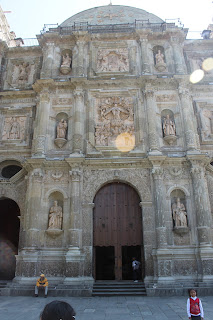The two protagonists of the Inaugural Concert of the Festival of Organ and Early Music in Oaxaca this past Thursday, February 18th, were Liuwe Tamminga on the Organ and Bruce Dickey on the Cornetto.
Although born in the Netherlands, Tamminga has spent most of his professional life in Italy, and specifically at the Saint Petronius Basilica in Bologna, where he has became one of the leading exponents of 16th and 17th Century Italian Baroque Organ Music. He plays regularly at Saint Petronius on the organs created by Lorenzo da Prato in the late 15th Century and Baldassarre Malamini at the end of the 16th Century.

Tamminga has brought back into the mainstream composers such as Marc'Antonio Cavazzoni, Frescobaldi and Giovanni Gabrieli. He has received the Diapason d'Or, the Preis der Deutschen Schalplatenkritik and the Goldberg 5 Star awards. He performs throughout Europe, the United States and Japan on a regular basis.
Bruce Dickey is responsible for the revival of the "cornetto", a very expressive wind instrument that fell into disuse from the beginning of the 19th Century. He has also received the Diapason d'Or for his CD "Quel lascivissimo cornetto". He founded with Charles Toet Concerto Palatino.
Tammina and Dickey started out with Giovanni Gabrieli's early 17th Century "Canzon II of the XII Tone". Then Tamminga did a solo on the organ interpreting Thoinot Arbeau's "Pavane Belle, qui tiens ma vie."
The concert featured compositions by Antonio de Cabezón, Fraancisco Correa de Arauxo, Bernardo Storace, Ascanio Trombetti, Santiago de Murcia, Diego Fernandez de Huete, before we listen to the Dilectus Meus by Giovanni Pierluigi di Palestrina, rendered even more delectable by the duo of Tamminga and Dickey
The organ we listened to was not the first one built for the Cathedral of Oaxaca by Agustin de Santiago in 1570, but rather the organ built by Matias de Chavez in 1711, which used some of the original pipes of Santiago's organ. This organ was modified several times during the 18th, 19th and 20th Centuries, seemingly in attempts to "modernize" it. From 1960 up until 1997, the organ was silent, until Father Fernando Vazquez Nunez of the Cathedral asked for the support of Fomento Cultural Banamex.
When most of us envision a Baroque Organ festival, the first thing that comes to mind is Bach and the Organ being played solo. To us, not frequent followers of Baroque Organ Music, we were in for a few delightful surprises, not the least being the combination of the organ with a wind instrument.
What we neophytes discovered in this Festival was the varied nature of Baroque Organ Music, and how much of a light and uplifting experience it can provide. Another discovery was how complex and beautiful the organs built by Oaxacan constructors were. Halfway through this first concert, the keyboard assistant pushed a special register that made the piece sound as if it were being accompanied by bird song. These were "special audio effects" from the 18th Century, whereby air was pushed from the bellows, into the box, and then through a tube surrounded by water.
Enjoy a fragment of fine Baroque organ music
interpreted by master Liuwe Tamminga,
playing the Cathedral of Oaxaca Organ,
soberly accompanied by the cornetto of
Bruce Dickey
View from the Choir toward
the main altarpiec
Back door of the Cathedral
Side door of the Cathedral
Bell tower and side view of
Cathedral
Choir area and organ
One of the two side aisles of
the Cathedral
Main façade of the Cathedral
Front view of the Cathedral
Carved granite saints on
Baroque Façade of Cathedral
Ornate stone carving on the
Façade of the Cathedral
Baroque style stone carving and decoration took
on a special style in the 17th and 18th Centuries
in Oaxaca
Side altarpiece of Cathedral




























No comments:
Post a Comment